Unlocking the Power of Vibrating Screens in Material Processing
Vibrating screens are essential components in the field of material processing, particularly in the manufacturing and processing machinery sector. They serve a vital function in the separation and classification of materials, ensuring that only the desired products are processed further. Understanding how vibrating screens work can significantly enhance operational efficiency and product quality i
Aug 09,2025

Vibrating screens are essential components in the field of material processing, particularly in the manufacturing and processing machinery sector. They serve a vital function in the separation and classification of materials, ensuring that only the desired products are processed further. Understanding how vibrating screens work can significantly enhance operational efficiency and product quality in various applications.
At its core, a vibrating screen consists of a screen surface that vibrates to facilitate the sorting of materials based on size and shape. When material enters the vibrating screen, the oscillation causes the particles to move across the screen. The design of the screen—such as its mesh size and angle—determines how effectively the materials can be separated. This mechanism is particularly advantageous in industries such as mining, recycling, and agriculture, where the separation of different material sizes is crucial.
One of the primary benefits of using vibrating screens is their ability to improve the quality of the end product. By accurately separating materials, businesses can reduce contamination and ensure that only the desired particles proceed to the next stage of processing. This increased precision not only enhances product quality but also boosts operational efficiency, as less time and resources are wasted on handling undesired materials.
Moreover, vibrating screens are known for their versatility. They can be used to screen a wide variety of materials, including aggregates, coal, minerals, and even food products. This adaptability makes them an invaluable tool in many manufacturing processes. Different configurations—such as linear and circular screens—allow companies to choose the right equipment for their specific needs, enhancing operational flexibility.
The integration of vibrating screens in manufacturing processes also contributes to sustainability efforts. By effectively sorting materials, companies can minimize waste and ensure that resources are utilized more efficiently. This not only helps in meeting regulatory requirements but also aligns with growing consumer expectations for sustainable practices in manufacturing.
Maintenance is another critical aspect of operating vibrating screens. Regular inspection and upkeep can prolong the life of the equipment and ensure consistent performance. Addressing issues such as worn-out screens or mechanical failures promptly can prevent downtime and maintain the efficiency of the production flow.
In conclusion, vibrating screens are indispensable in the manufacturing and processing machinery sector. They enhance material separation and classification, improve product quality, and support operational efficiency. As industries continue to evolve, the role of vibrating screens will remain pivotal in driving productivity and sustainability in material processing applications. By investing in the right vibrating screen solutions, businesses can unlock new levels of efficiency and quality in their operations.
At its core, a vibrating screen consists of a screen surface that vibrates to facilitate the sorting of materials based on size and shape. When material enters the vibrating screen, the oscillation causes the particles to move across the screen. The design of the screen—such as its mesh size and angle—determines how effectively the materials can be separated. This mechanism is particularly advantageous in industries such as mining, recycling, and agriculture, where the separation of different material sizes is crucial.
One of the primary benefits of using vibrating screens is their ability to improve the quality of the end product. By accurately separating materials, businesses can reduce contamination and ensure that only the desired particles proceed to the next stage of processing. This increased precision not only enhances product quality but also boosts operational efficiency, as less time and resources are wasted on handling undesired materials.
Moreover, vibrating screens are known for their versatility. They can be used to screen a wide variety of materials, including aggregates, coal, minerals, and even food products. This adaptability makes them an invaluable tool in many manufacturing processes. Different configurations—such as linear and circular screens—allow companies to choose the right equipment for their specific needs, enhancing operational flexibility.
The integration of vibrating screens in manufacturing processes also contributes to sustainability efforts. By effectively sorting materials, companies can minimize waste and ensure that resources are utilized more efficiently. This not only helps in meeting regulatory requirements but also aligns with growing consumer expectations for sustainable practices in manufacturing.
Maintenance is another critical aspect of operating vibrating screens. Regular inspection and upkeep can prolong the life of the equipment and ensure consistent performance. Addressing issues such as worn-out screens or mechanical failures promptly can prevent downtime and maintain the efficiency of the production flow.
In conclusion, vibrating screens are indispensable in the manufacturing and processing machinery sector. They enhance material separation and classification, improve product quality, and support operational efficiency. As industries continue to evolve, the role of vibrating screens will remain pivotal in driving productivity and sustainability in material processing applications. By investing in the right vibrating screen solutions, businesses can unlock new levels of efficiency and quality in their operations.
TAG:
Contact Us
E-mail :
Phone/WhatsApp:
Address:
Shunping, Baoding City, Hebei Province









